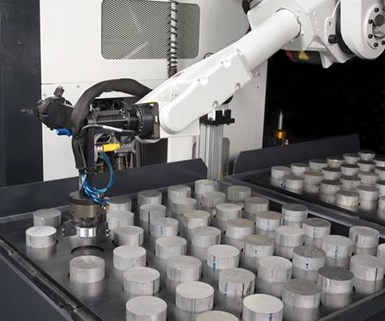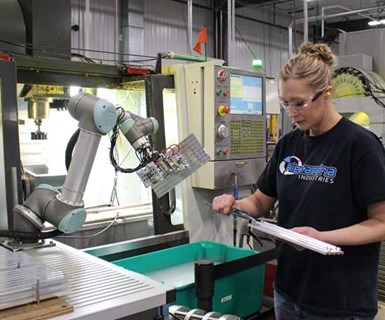Interest in Robotic Automation for CNC Machine Shops Increasing
Have you considered how robots can be beneficial to your shop?
#Industry40 #covid-19

Total unit orders for robots last year was nearly 30,000. This is a 1.6% increase from 2018 orders.
According to the Robotic Industries Association (RIA), part of the Association for Advancing Automation (A3), robot unit orders in North America last year increased by 1.6% compared to 2018. The total number of robots ordered in 2019 was 29,988. The RIA says the largest driver of the growth was a 50.5% increase in orders from automotive OEMs and a 16.6% increase from the plastics and rubber industry.
Production Machining editors have encountered anecdotal evidence of precision machine shops’ increasing interest in robots. This type of automation can add capacity by taking advantage of time that’s currently unused, like nights and weekends. Plus, skilled employees are becoming harder to find. This makes a company’s current set of talented employees so valuable that they need to leverage that value as far as it will go. It can also help shops maintain steady production when employees are unavailable for work, which today can be a reality given the worldwide coronavirus outbreak. And while any high-production manufacturing plant is the natural candidate for robotic automation, even small shops are now beginning to consider it.

Some collaborative robots use sensor technology to detect when they unexpectedly contact an object or person.
Today’s robots are faster and more intelligent than ever before. Latest vision technology as exemplified by high-speed, high-definition cameras offer improved part recognition capability for picking operations. Offline robot programming tools are becoming more powerful and intuitive, too. In addition, some robots can work safely alongside employees. A current trend in manufacturing robotics is the application of collaborative robots, or “cobots.” These robots use sensor technology that enables them to function safely alongside humans in a shared work environment. That means no more isolating fencing is needed to separate worker and robot.
We’ve recently published various articles on this topic. For example:
This one highlights the challenges integrating robots in a high-mix/low-volume environment.
This one describes eight variables that shops new to such automation should consideration prior to adding robots.
This one details one shop’s experiences adding cobots.
And this one serves as a beginner’s guide to robotic automation.
If you’re using and benefiting from robots in your shop, send me an email briefly describing how. Conversely, if robots don’t seem right for your operation, I’d like to hear why you feel that’s the case.
RELATED CONTENT
-
Automation in High-Mix, Low-Volume Turning Applications
Turning shops are familiar with automation for high-volume work, but the shifting landscape to smaller batch sizes has created new challenges.
-
Industry 4.0 Careers of the Future
Know a young person considering a career pathway? Encourage him or her to consider these careers.
-
Job Shop Automation: Fast, Simple and Agile
When done right, automation can provide important benefits. Here’s a look at automation options to suit the varying needs of typical job shops.
.png;maxWidth=970;quality=90)

.jpg;width=70;height=70;mode=crop)
